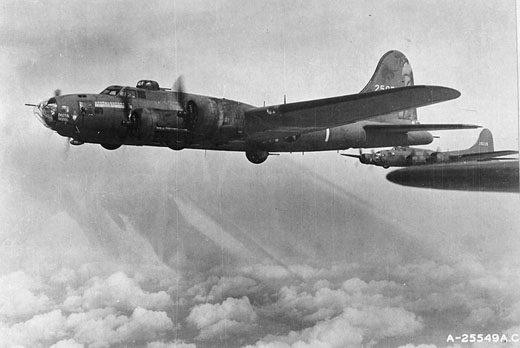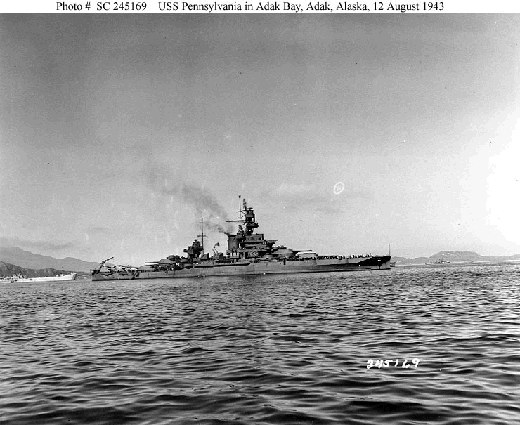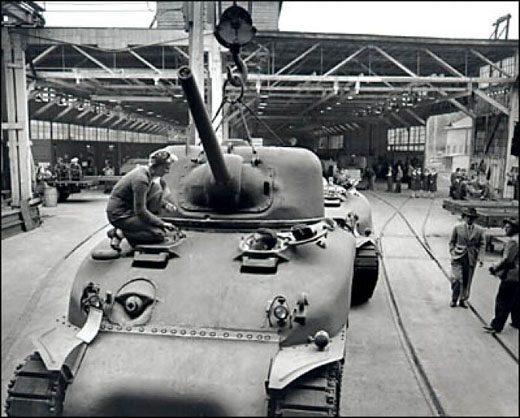Air Operations, Aleutians
28th Composite Bomb Group B-24s and B-25s based at the airfield on Adak Airdrome mount 26 sorties against Kiska through the day. B-24s, B-25s, A-24s, and 343rd Fighter Group P-38s and P-40s based at the airfield on Amchitka mount 70 sorties against Kiska through the day.
[Air Operations, Bismarcks
- 1 V Bomber Command B-24 attacks the Cape Gloucester airfield on New Britain.
- 3rd Light Bomb Group A-20s attack Gasmata.
Air Operations, Europe
330 heavy bombers of the 8th Air Force are sent to the Ruhr and Bonn. Strong defenses, a thick cloud cover and smoke screens hamper the bombing. Capt Clark Gable, the movie star, flies in the leading B-17 of the 351st Bomber Group.
RAF BOMBER COMMANDEvening Ops:
- 321 Lancasters and 183 Halifaxes carry out a successful raid on Milan. 1,252 tons of high explosive and incendiary bombs are dropped on Milan in the heaviest raid yet suffered by an Italian city. Among the buildings hit are the Castello Sforzesco, the Palazzo Reale and almost all the buildings in the center of the city.
- 2 Halifaxes and 1 Lancaster are lost.
- 152 aircraft of Nos. 3 and 8 Groups bomb Turin. Included in the total are 112 Stirlings, 34 Halifaxes and 6 Lancasters.
- 2 Stirlings are lost.
- 7 Mosquitos are sent to Berlin, 24 Wellingtons lay mines off the Brittany ports and there are 9 OTU sorties.
- 1 Mosquitos and 2 mine-laying Wellingtons are lost.
BELGIUM:
In their unit's first individual mission, 27 353rd Fighter Group P-47s conduct an unchallenged and uneventful sweep across the Belgian coast.
US 8th AIR FORCEGERMANY:
- 133 1st Heavy Bomb Wing B-17s attack Bochum, Gelsenkirchen, Recklinghausen, and several targets of opportunity.
- Flak and Luftwaffe fighter opposition down 23 bombers, 103 are damaged, 2 crash-land in the UK and are written off; 5 crewmen are killed, 49 wounded, 232 missing
- 110 4th Heavy Bomb Wing B-17s attack the city of Bonn and several targets of opportunity between 0850 and 0900 hours.
- 2 B-17s are lost, 70 damaged; 1 crewman is killed, 7 wounded, 21 missing
- Using pressurized steel belly tanks for the first time, 131 P-47s of the 4th, 56th, and 78th Fighter Groups undertake penetration and withdrawal escort sorties, during which 4 Luftwaffe fighter are downed by planes of the 4th Fighter Group.
ITALY:
- NASAF B-25s attack the Crotone Airdrome.
- NASAF B-26s attack the Grazzanise Airdrome.
- During a large engagement over the Grazzanise Airdrome at 1300 hours, 1st Fighter Group p-38s down 2 and damage or possibly down 8 Axis fighters. B-26 gunners claim 9 Axis fighters during this action.
Air Operations, New Guinea
V Bomber Command B-25s attack a road near Bogadjim.
[ 'Delta Rebel No. 2' Boeing B-17F Shot Down over Germany |
 |
Air Operations, Pacific
B-24s bomb Paramushiro and Shimushu in the Kurile Islands.
[Air Operations, Sicily
- NATAF A-20s and NATAF and IX Bomber Command B-25s attack several Axis-held towns near the battlefront.
- NATAF A-36s and P-40s provide direct support for Allied ground forces and, with IX Fighter Command P-40s, attack Axis shipping in the Straits of Messina and along the northeastern coast.
- In their unit's first action in the Sicily Command on a mission against shipping traffice in the Straits of Messina, 79th Fighter Group P-40s down 1 FW-190 and damage or possibly down 4 other Axis fighters.
Air Operations, Solomons
- 25 XIII Bomber Command B-24s, escorted by 8 AirSols P-40s and 22 F4Us, attack the Kahili airfield on Bougainville with 520 100-pound bombs.
- In several engagements through the day, Marine Corps F4Us down 4 A6M Zeros over Choiseul and Bougainville. 1 18th Fighter Group P-40 downs an A6M Zero over Kahili at about 1250 hours. 1 P-40 and 1 F4U are lost in the day's action.
Air Operations, Tunisia
52nd Fighter Group Spitfires down 1 FW-190 and damage another in an engagement 10 miles off Bizerte at 1850 hours.
[Aleutians
5 US cruisers and 5 destroyers carry out the last pre-invasion bombardment of Kiska Island, firing over 60 tons of shells.
USS Pennsylvania (BB-38) |
 |
Eastern Front
In the Kharkov sector Chuguyev falls to the Soviets. The threat to Poltava is more serious, however, for if it is taken not only will the garrison of Kharkov be almost certainly cut off, but the German forces farther south will also be in grave danger. The III Pzr Corps is therefore brought back north from the Taganrog area. The Red Army advance on the Bryansk front continues.
SOUTHERN SECTORThe 1st Tank Army renews its attack yet again and recaptures Vysokopolye. Once more the Germans launch ferocious counterattacks. Chuguyev falls to the 57th Army while elements of the Steppe Front enter the outskirts of Kharkov.
[Italy, Politics
Gen Giusepppe Castellano leaves by train for Madrid. He is to meet the British ambassador to Spain, explain the Italian military situation to him, learn what are the Allies' intentions, if any, and, above all, say that Italy cannot drop her German ally without help from the Western Allies.
[Sicily
Reports come in of large-scale German evacuation. 4 German divisions, about 40,000 men, escape with 50 tanks, plus about 62,000 Italians. In the American sector, the divisions of the II Corps push on eastwards. The 9th Div reaches Floresta, north of Randazzo, the last stronghold along the II Corps line of advance.
[Solomons
Advance guards of the invasion forces leave Rendova and land near Barakoma, on Vella Lavella, during the night to prepare the ground for the main body. They find only a few Japanese. One company (Company L, 169th Infantry, 43rd Division) lands on the islet of Baanga to establish a bridgehead there, but is driven back into the sea with heavy losses by the little Japanese garrison.
[Sweden
The Swedish submarine Illern is sunk after a collision with a merchant ship.
[ Sherman Tanks Being Made in Seattle |
 |
One of the bravest Victoria Crosses is won on this night. A Stirling of 218 Squadron is badly damaged by a burst of fire while approaching Turin. The navigator is killed and several members of the crew are wounded, including the pilot, Flight Sergeant Arthur Louis Aaron, who is struck in the face by a bullet which shatters his jaw and tears away part of his face; he is also injured in the chest and his right arm cannot be used. The flight engineer and the bomb aimer take over the controls of the aircraft and set course for North Africa although one engine is useless, the pilot is out of action, having been dosed with morphia, and the navigator is dead. The Stirling reaches the cost of Africa and Flight Sergeant Aaron insists on returning to his seat in the cockpit to help prepare for the landing. Twice he tries to take over the controls and, although he has to give up this attempt, he continues to help by writing down instructions for landing with his left hand. He cannot speak. Under Aaron's guidance, given in great pain and at the limits of exhaustion, the Stirling lands safely at its fifth attempt at Bône airfield with its wheels up. Flight Sergeant Aaron dies 9 hours later. It is considered that he might have survived if he had rested after having been wounded instead of insisting on helping his crew. The wireless operator, Sergeant T Guy, and the flight engineer, Sergeant M Mitcham, are each awarded the Distinguished Flying Medal. It is later established that the machine-gun fire which struck the Stirling had been fired by a nervous tail gunner in another bomber. Flight Sergeant Aaron was 21 years old and came from Leeds.